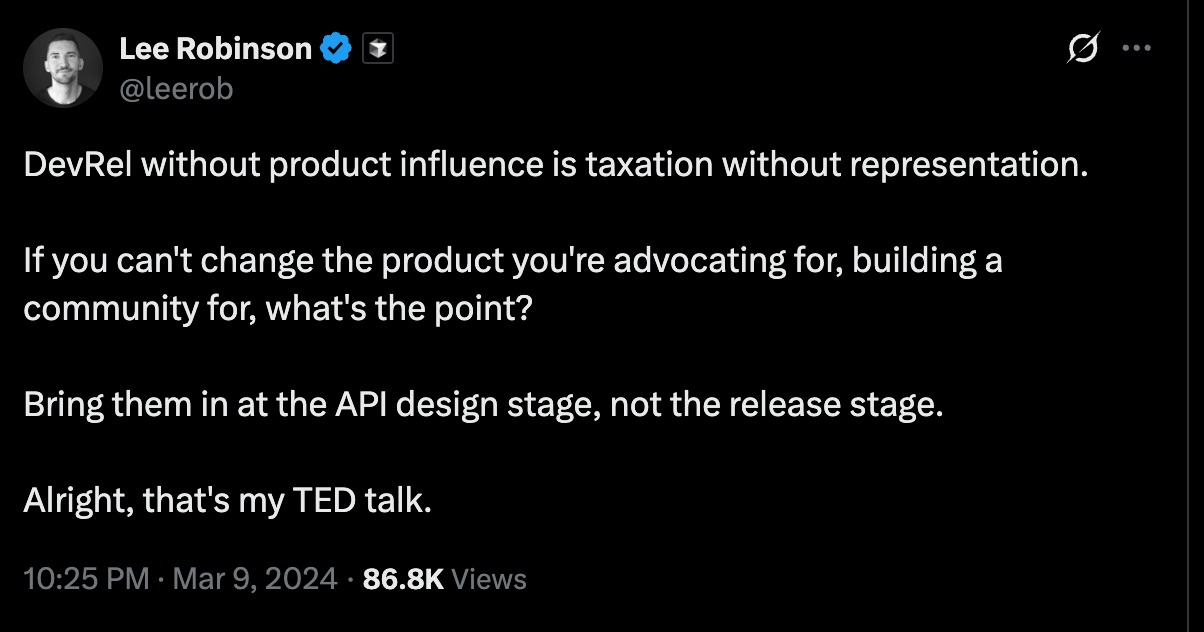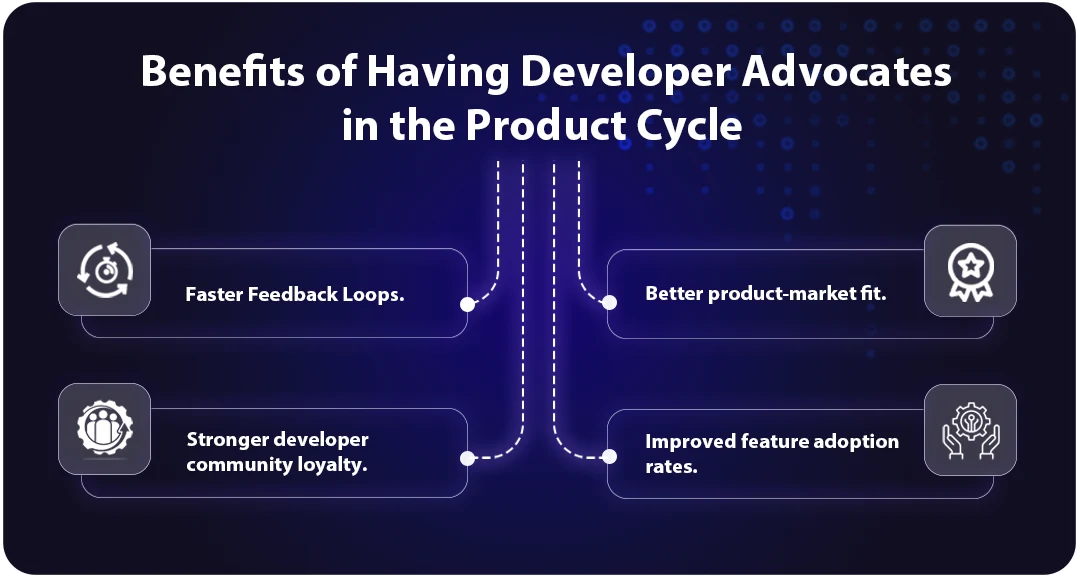TL;DR
- Developer Advocates (DAs) bridge the gap between engineering and product teams by translating technical concepts into business insights, bringing real user feedback into decision-making, and advocating for developer experience (DX).
- They align priorities, break down communication barriers, and ensure both teams work towards shared goals. This results in faster releases, better product quality, and stronger developer communities.
- In B2B SaaS, AI, and other tech-driven industries, DAs are becoming a competitive advantage, turning products from simply “launched” to co-created with their communities.
- Different priorities (business KPIs vs. code quality), jargon-heavy communication, and siloed workflows create misunderstandings, delays, and missed opportunities, creating a gap between the Engineers and the product team.
What is a Developer Advocate?
Developer Advocacy is the practice of building strong and two-way relationships between a company and its community. A Developer Advocate serves both as a bridge and a translator, connecting the team that designs and builds products with the product users.
A Developer Advocate’s or a DA’s job is to represent the needs of developers and focus on improving their experience to ensure easier adoption of technology in startups or any organisation, such as Vercel, Tailscale, or Google.

Lee Robinson, VP of Product at Vercel, on DevRel.
Tired of wasting engineering time on content?
Understanding the Developer Advocate Role
Developer advocacy is a strategic approach focusing on building relationships with developers, ensuring they have a positive experience, and addressing their needs. In simple words, a developer advocate is equal parts techie, translator, and community cheerleader. The position of Developer Advocacy acts as the voice of developers within a company, representing their interests and ensuring that the product decisions align with the developers’ requirements.
In B2B SaaS and AI-driven businesses, this role is becoming a competitive advantage. Products are no longer just “launched” but co-created with the community, and DAs are the ones making sure that co-creation actually happens.
A great example can be seen in brands like Freshworks, where DAs work hand-in-hand with product and engineering teams to ensure tools integrate without an issue. This way, friction points are resolved quickly, and developers genuinely enjoy using the product. Developer advocates are the ones making sure this co-creation actually happens.
Why the Gap Exists Between Engineers and Product Teams?
The disconnect between engineering and product teams isn’t just a myth but a recurring reality in many organizations.
This gap usually stems from different priorities, contrasting communication styles, and a lack of shared context.
Product teams are laser-focused on market needs, user experience, and hitting business goals. They think in terms of growth metrics, competitive edge, and quick wins that can ship fast.
Engineering teams, on the other hand, are guardians of technical quality. They care about scalability, maintainability, clean code, and reducing technical debt. Their lens is often long-term, building robust, future-proof solutions.
When these mindsets aren’t aligned, the result can be misunderstandings, slower releases, and products that miss their mark. Now, the most important question is, how do you overcome this gap?
Different Priorities
Product Teams:
- Chase user needs, market demands, and business KPIs like revenue and retention.
- Value short-term deadlines and speed to market.
Engineering Teams:
- Prioritize code quality, scalability, maintainability, and avoiding tech debt.
- Invest in sustainable architecture, even if it means longer build cycles.
Communication Barriers Between Engineers and Product Teams
- Too much jargon: Engineers speak “code,” while product managers speak “customer.” The translation doesn’t always land.
- Conflicting perspectives: What’s “must-have” for a product may be “technically unrealistic” for engineering.
- Lack of transparency: Without open updates on technical limitations or progress, trust erodes.
Missing Shared Understanding
- Vision clarity: Engineers need the “why” behind each feature to build it effectively.
- Early involvement: Engineering input on feasibility and constraints should happen at the start and not after the scope is set.
- Business context: Engineers build better when they understand the bigger business picture.
Organizational Hurdles
- Siloed structures: When teams operate in isolation, alignment suffers.
- Imbalance of authority: In some orgs, the product gets the final say, leaving engineering feeling like order-takers rather than partners.
Consequences of the Gap
- Delayed launches from rework or missed requirements.
- Stifled innovation when technical insights are not integrated into any strategy.
- Lower product quality from misaligned priorities.
How Developer Advocates Bridge the Gap

When the product and engineering teams speak the same language, both literally and figuratively, things start to align. Products launch faster, quality improves, and teams actually enjoy working together. Let us learn a step-by-step guide to developing an effective marketing strategy and bridging the gap between Engineer and the Product teams.
Translating Technical Concepts into Business Insights
Let’s be honest, technical explanations can sometimes sound like an alien language to someone who doesn’t belong to a technical field. A DA takes a complex engineering decision and breaks it down so product teams can see the business value and trade-offs, and provides actionable recommendations for product decisions.
Example: Instead of saying, “This API refactor reduces cyclomatic complexity,” they might say, “This change makes our integration faster and easier to maintain, which means fewer bugs for users and faster shipping for us.”
Bringing User & Developer Feedback to Product Teams
DAs are plugged directly into the developer communities such as Discords, GitHub issues, Twitter threads, or conference hallways. They absorb the raw, unfiltered truth about how your product feels in the wild.
They then distill this into actionable insights for the product teams, helping them prioritize what really matters. That could mean advocating for better error messages over shiny new features, because usability wins long-term loyalty.
Facilitating Cross-Functional Communication
Ever seen people nodding in a meeting while secretly thinking completely different things? Developer advocates bridge that mental gap for Engineers and the internal product team.
They:
Run workshops where both sides brainstorm together.
Create documentation that works for tech and non-tech audiences.
This creates a shared language and way for success, cutting down on friction and speeding up releases.
Advocating for Developer Experience
Developer Experience or DX is nothing but the user experience for Developers and Developer Advocates, as its name suggests, advocates fight for DX.
The DA fights for:
- Product features and ensure they meet the developer's usability standard\
- Clear documentation
- Tooling that gets developers from zero to ‘it works!’ faster.
Benefits of Having Developer Advocates in the Product Cycle

By now, you must have understood how a DA works for B2B SaaS, AI brands, or any other companies. If you are considering having a Developer Advocate in your organization, you must want to know other benefits that will make you change your mind.
Faster feedback loops.
Better product-market fit.
Stronger developer community loyalty.
Improved feature adoption rates.
Skills That Make a Developer Advocate Effective
If you are here, that means you are in fact considering adding a DA to your team. Here are a few must-have experiences and skills that make a Developer Advocate an excellent one:
Technical expertise and communication skills.
Empathy and active listening.
Understanding both business and developer needs.
Every devtool startup needs content. Most do it wrong.
Conclusion
In the fast-paced and tech-driven field we are in, developer advocacy has emerged as one of the most critical functions that bridges the gap between engineering and marketing teams. Their role in facilitating feedback and combining technical expertise with effective communication and community-building skills is instrumental.
FAQ
1. What’s the difference between a product team and an engineering team?
The product team focuses on identifying the problem, what it is, why it matters, and how solving it aligns with business goals. The engineering team focuses on building the solution, translating documented requirements into functional, scalable, and high-quality products.
2. Who is responsible for communicating between engineers, customers, and other stakeholders?
Product managers typically serve as the communication hub, sharing insights from market research, customer feedback, and business priorities with engineering teams. This ensures everyone stays aligned on what to build and why it matters.
3. Why is there often a gap between product and engineering teams?
Misalignment often happens due to different priorities, communication styles, and a lack of shared understanding. Product teams are market-driven, while engineering teams are technology-driven; bridging these perspectives is key to faster, better product development. Read this blog to learn more about.
4. How does a developer advocate help connect engineers and product teams?
A developer advocate acts as a translator between the technical and non-technical worlds. They explain complex engineering concepts in business terms for product teams and bring real-world user feedback to improve the products.
5. Is Technical Evangelism the same as Developer Advocacy?
No, while both focus on engaging with developers, technical evangelism focuses on promoting a product or technology, while Developer Advocacy focuses on supporting and advocating for developers and connecting the internal team by gathering feedback and sharing it with the developer community.
6. How to become a developer advocate?
You can become a developer advocate by blending strong technical skills with communication and community-building abilities. Most developer advocates start with a background in software development, engineering, or a related technical field, then branch into roles that involve public speaking, content creation, and developer relations.

